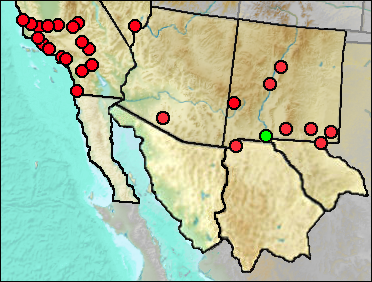Class Mammalia
Order Perissodactyla
Family Equidae
Equidae—Family Equidae // Equidae sp.—Horses // Equus sp. (small)—Small Horse // Equus sp (large)—Large Horse // Equus calobatus—Stilt-legged Onager // Equus conversidens—Mexican Horse // Equus cumminsii—Cummings' Ass // Equus enormis—Enormous Horse // Equus fraternus—Fraternal Horse // Equus giganteus—Giant Horse // Equus occidentalis—Western Horse // Equus pacificus—Pacific Horse // Equus (Plesippus) sp.—American Zebra // Equus (Plesippus) francescana—Francescana Zebra // Equus (Plesippus) simplicidens—American Zebra // Equus Species A—Unidentified Equus // Haringtonhippus francisci—Harington's Stilt-legged Horse

The position of E. occidentalis in relation to other Southwestern taxa is unclear, with the taxon having been erected on the basis of an isolated tooth that has been undiagnostic at the species level. The Rancho La Brea horse has long been assigned to this species, but because the name cannot be associated with diagnostic material, Winans (1985) treated E. occidentalis as a nomen dubium and assigned the Rancho La Brea horse to E. mexicanus. In her 1989 paper, Winans included E. mexicanus in her E. laurentius group and assigned the larger horses from Dry Cave to that group. It should be understood that my use of E. occidentalis is solely to indicate relationship to the Rancho La Brea horse, and is not meant as a nomenclatural statement.
Winans' assignment of the larger Dry Cave horses to a taxon equivalent to E. occidentalis creates a problem, however. Relying on measurements by Willoughby (1974) of the Rancho La Brea (RLB) specimens traditionally treated as E. occidentalis (= Winans' E. mexicanus), the Dry Cave (DC) horses average smaller with the exception of the horse (UTEP 31-57) identified by Porter and Harris as E. scotti; the metacarpal of the latter associates nicely with the Rancho La Brea specimens in cluster and principal components analyses (see Fig. 2 of the Equus account). Another problem is that the Rancho La Brea taxon apparently lacks an infundibulum on any of the lower incisors (Bennett 1980), whereas the Dry Cave horses identified as E. niobrarensis have them.
For the present, the largest elements from the late Wisconsin of Dry Cave, including UTEP 31-57, are referred to E. occidentalis; in view of nomenclatural problems, this assignment is meant only to indicate likely conspecificity with the Rancho La Brea horse. A large anterior lower mandible from the Early or Early Mid Wisconsin with deciduous and permanent incisors lacking infundibulae (UTEP 26-1064) earlier referred to this species is transferred to E. conversidens (see that account). The Dry Cave horses identified by Harris and Porter (1980) as E. niobrarensis are retained under the name of E. scotti.
Sites.
Early Irvingtonian: Adobe Ranch (UTEP).
?Late Irvingtonian/Rancholabrean: Emery Borrow Pit (Jefferson 1991b).
Rancholabrean: Arbogast Ranch (Jefferson 1991b: cf.); Bakersfield Canal Cutting (Jefferson 1991b); Camarillo Hills (Jefferson 1991b); Cool Water Coal Gasification Site (Jefferson 1991b); Coronado Beach, San Diego (Jefferson 1991b); Irish Canyon (Jefferson 1991b: cf.); Lake View Hot Springs (Jefferson 2014: cf.); Metro Rail Hollywood Tunnel (Jefferson 2014); Nash Draw (UTEP: ?); Park La Brea A (Jefferson 2014);Park La Brea B (Jefferson 2014); San Buenaventura (Jefferson 1991b); Santa Maria Oil Spring (Jefferson 1991b); Santa Paula (Jefferson 1991b).
Wisconsin: Carpinteria (Wilson 1933: cf.).
Early/Early-Mid Wisconsin: Rm Vanishing Floor (Harris and Porter 1980).
Mid Wisconsin: McKittrick (Schultz 1937); Pendejo Cave (UTEP: ?); U-Bar Cave (Harris 1987: cf.).
Mid/Late Wisconsin: Diamond Valley (Springer et al. 2009); Rancho La Brea (Stock and Harris 1992: cf.); U-Bar Cave (UTEP).
Late Wisconsin: Balcony Room (Harris 1993c: ?); Calico Lakes (Jefferson 1991b: cf.); Charlies Parlor (UTEP); China Lake (Jefferson 1991b: cf.); Dove Springs Megafaunal Loc. (Jefferson 2014: cf.); Gypsum Cave (Jefferson et al. 2015: cf.); Human Corridor (Harris 1993c); Isleta Cave No. 2 (UTEP); Luz Solar Trough (Jefferson 1991b); Salt Creek (UTEP: ?); Sandia Cave, Folsom Level (Hibben 1941: cf.); Solar One (Jefferson 1991b: cf.); Ventana Cave (Colbert 1950).
Literature. Bennett 1980; Colbert 1950); Harris 1987, 1989, 1993c; Harris and Porter 1980; Hibben 1941; Jefferson 1991b, 2014; Jefferson et al. 2015; Schultz 1937; Springer et al. 2009); Stock and Harris 1992); Willoughby 1974; Wilson 1933); Winans 1985.
Last Update: 7 Jul 2018